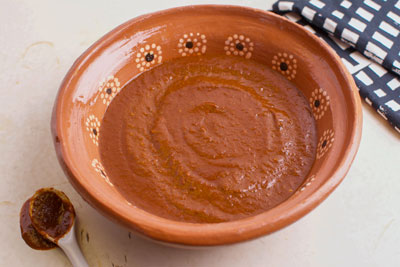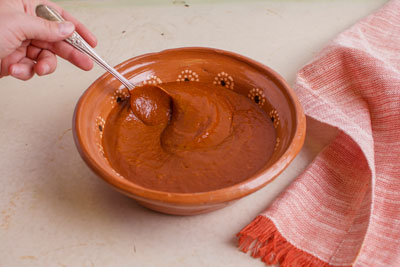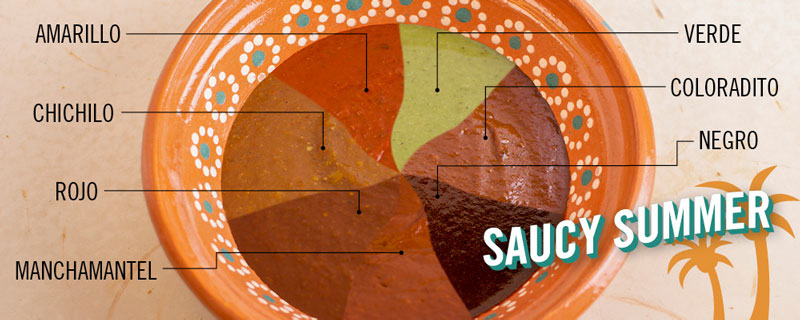Let’s go back to the beginning. Back to when I was full of hope and known as Michael, rather than “lone figure.” Back to when a boy with a dream (me again) and a love for mole embarked on a quest from which he would (most likely) never return.
*epic theme music plays*
What is mole?
It’s pronounced “moal-ay” (sorry not sorry if you read that whole first paragraph thinking small, sightless rodents had taken over the Savory Spice Test Kitchen). The word literally means “sauce”. Key cooking methods and ingredients distinguish moles from other sauces, but this subcategory is really quite flexible and countless versions can be found across Mexico and in Mexican homes worldwide. Most moles are going to follow this basic formula: toast dried chiles, roast/blacken some veggies, throw in some nuts, seeds, dried fruit, bread or masa, and maybe some chocolate and puree it into a smooth sauce to be served with meat (usually turkey or chicken). The key principle is developing flavor through the cooking process of each and every element to achieve mole’s characteristic complexity.
Mole is the national dish of Mexico with the Pueblan and Oaxacan states of Mexico being the most famous places to get your mole on. Puebla is generally regarded as the birthplace of mole but Oaxaca has claimed seven mole babies as its own: rojo, coloradito, amarillo, verde, negro, chichilo, and manchamantel. I’ve been trying moles at local restaurants and even making a few myself for years, but decided it was time I flew to Oaxaca to experience the OG Oaxacan Seven for reals. I was about to stuff a duffel with Tupperware and stretchy pants when I remembered that planes cost money. Undeterred, I decided that instead, I would try making all seven moles myself. By hand. From scratch. And in seven days.
*A few notes before we jump in. Click on the headings for each mole to see the recipes I used. Some of the recipes call for ingredients to be used as a garnish, meaning they remain separate from the sauce in pieces, like a stew. These are included in the ingredients shots but not in the shots of the finished mole. All of the recipes also include chicken stock, though it isn’t pictured.
Mole Rojo is the most common and widely served, at least in the U.S. It’s also known as mole poblano or colorado, which means “reddish.” The first step was to fry a trio of dried chiles in lard (very traditional). In my defense, mulato, ancho, and pasilla chiles are basically black to start, so it’s hard to tell if you’re burning the bajeebies out of them or not. I did. Whoops. I proceeded to soak the chiles anyways, exercising a little faith that the burnt bitterness would not overpower the mole. A little pureeing, stirring, and reducing later I had a gorgeous, dark red mole that tasted like straight ash. Behind the bitterness, I could taste the complex flavors of what would have otherwise been a delicious mole: nuttiness, warm spices, and fruity sweetness. Thankfully, I still had six days and six moles to go; plenty of time to redeem myself.
Spoiler alert: This isn’t the last time I will burn my chiles this week. To skip this step and jump straight to choco-tastic mole flavor, try our mole blend! It already includes 11 of the ingredients pictured below so you can spend less time frying chiles in lard and more time rubbing chocolate all over your face and clothes so you can pretend that it took you all day to make mole when it actually took you 45 min.

 Mole rojo ingredients (from left to right...ish): cinnamon, tomatillos, mulato chiles, darkly toasted bread, pasilla chiles, black peppercorns, raisins, almonds, lard, garlic, star anise, cloves, ancho chiles, sugar, chocolate, and sesame seeds.
Mole rojo ingredients (from left to right...ish): cinnamon, tomatillos, mulato chiles, darkly toasted bread, pasilla chiles, black peppercorns, raisins, almonds, lard, garlic, star anise, cloves, ancho chiles, sugar, chocolate, and sesame seeds.Also known as little red because of its similarities to mole rojo, this mole is basically a glorified enchilada sauce (all moles make great enchilada sauces btw). The guajillo chiles in this mole are slightly sweet and tangy with a similar heat level to a jalapeno. The mysterious brown cone in the ingredient shot below is called piloncillo: unrefined brown sugar with a strong molasses flavor that you have to grate. Throw in some tomatoes and extra chocolate and you have a slightly sweeter, slightly spicier reddish-orange mole. This time I was determined not to burn my chiles so I tried a different cooking method. I dry roasted them at 450 degrees for 3 min. I just about jumped out the kitchen window (don’t worry, it’s on the first floor) when I pulled them out of the oven and some of the smaller chiles had burned! This was proving to be the most challenging part of making mole.

 Mole coloradito ingredients: chocolate, guajillo chiles, raisins, sesame seeds, onion, ancho chiles, cinnamon, tomatoes, breadcrumbs, garlic, cloves, allspice, cumin seeds, piloncillo, and tomatillos.
Mole coloradito ingredients: chocolate, guajillo chiles, raisins, sesame seeds, onion, ancho chiles, cinnamon, tomatoes, breadcrumbs, garlic, cloves, allspice, cumin seeds, piloncillo, and tomatillos.While amarillo means yellow, this mole is typically bright orange. Most versions of this mole call for chiles that are hard to pronounce, let alone find outside of Oaxaca: chilhuacle and chilcostle chiles. Guajillo chiles are a great substitute. I also threw in some smoked serrano chiles for fun. You’ll also commonly see aji amarillo chiles in this mole, of which we carry a powdered version. This mole is typically spicier and less sweet than the previous two. The cilantro and masa add a welcome freshness to the sauce. But what you really want to know is whether I burned my chiles again, isn’t it? This time I dry toasted them in a skillet where I could keep a close eye on them. As they toast you can see small bubbles form and occasionally a reddish tint, which, along with a signature toasted chile fragrance, let you know when they are done. I highly recommended this method.

 Mole amarillo ingredients: onion, cumin seeds, allspice, cloves, aji amarillo powder, tomato, garlic, fresh masa, smoked serrano chiles, guajillo chiles, and cilantro. Garnish: Yukon Gold potatoes, chayote squash, green beans.
Mole amarillo ingredients: onion, cumin seeds, allspice, cloves, aji amarillo powder, tomato, garlic, fresh masa, smoked serrano chiles, guajillo chiles, and cilantro. Garnish: Yukon Gold potatoes, chayote squash, green beans.Mole verde wins the awards for easiest, freshest, and most monochromatic mole. Tomatillos (the green tomato-looking things with gooseberry-like husks) are used in six of the seven moles, but here they are the star of the show. When harvested early, tomatillos are light and sour and add a pleasant brightness to the sauce. Their flavor and subdued sweetness is enhanced with a little roasting. The trickiest part of this mole is achieving the right consistency without overcooking it and losing that nice green color. Just make sure you reduce your stock and masa puree before adding in your green puree. Have I mentioned yet that when you make mole you make fifty purees before combining them all at the end? Well, you do.

Four down, three to go. Mole negro has the most ingredients and therefore, I think, the most complex and interesting flavor profile. You also toast and blacken the seeds and pith of the dried chiles, which are normally discarded, and blend them into your sauce. This adds heat, bitterness, nuttiness, and a dark color. A little fried plantain puree adds sweetness and a creamy texture. Plus two and a half chocolate bars, which add an important layer of flavor but should never dominate. Take a wild guess what happened to that extra half.

 Mole negro ingredients: onion, garlic, pecans, peanuts, almonds, mulato chiles, white bread, tomatillos, tomato, raisins, cinnamon, smoked serrano chiles, sesame seeds, ripe plantain, Mexican oregano, allspice, cloves, pumpkin seeds, sugar, pasilla chiles, and chocolate.
Mole negro ingredients: onion, garlic, pecans, peanuts, almonds, mulato chiles, white bread, tomatillos, tomato, raisins, cinnamon, smoked serrano chiles, sesame seeds, ripe plantain, Mexican oregano, allspice, cloves, pumpkin seeds, sugar, pasilla chiles, and chocolate.If you tasted this mole you would think it should be called spicy corn mole. Chichilo actually means marmoset, which is a very small, very cute, yellowish-brown primate. I suppose this mole is named after a monkey because of the yellowish-brown color, but after a quick google image search I’d prefer to think it’s because these little guys just love mole and will visit you and eat out of tiny bowls if you make it for them (cut to me setting tiny bowls of mole on the window sill and attempting a marmoset mating call even though I have no idea what that sounds like). The delicious corn flavor comes from toasted corn tortillas and a generous amount of fresh masa, also known as masa preparada, which is a dough made from freshly ground hominy that can be found at specialty Mexican markets.

 Mole chichilo ingredients: avocado leaves, smoked serrano chiles, garlic, tomatillos, Mexican oregano, allspice, cloves, fresh masa, lard, corn tortillas, pasilla chiles, and onion. Garnish: red potatoes, green beans, and chayote squash.
Mole chichilo ingredients: avocado leaves, smoked serrano chiles, garlic, tomatillos, Mexican oregano, allspice, cloves, fresh masa, lard, corn tortillas, pasilla chiles, and onion. Garnish: red potatoes, green beans, and chayote squash.I’ve been looking forward to this one, and not just because it’s day seven and this is the last mole and I’m so tired and the kitchen is literally on fire right now. This one is fruity! I deviated from the recipe a little and caramelized the pineapple and plantain to enhance their flavors before blending them into a puree. Traditionally, all of these pastes and purees are made by grinding the ingredients using a molcajete or metate y mano (like a mortar and pestle). But if you’re like me and don’t have a big stone slab and a little club lying around, a blender works just fine. Also, the cinnamon really came through in this mole, perfectly complementing the caramelized fruit and fruity ancho chiles. Just don’t get it on your tablecloth (that’s what manchamantel means: tablecloth stainer).

 Mole manchamantel ingredients: pineapple, ancho chiles, garlic, sugar, lard, onion, black peppercorns, cloves, cinnamon, apple cider vinegar, and ripe plantain.
Mole manchamantel ingredients: pineapple, ancho chiles, garlic, sugar, lard, onion, black peppercorns, cloves, cinnamon, apple cider vinegar, and ripe plantain.I’m just as surprised as you are, but the hero of our story (you already know who it is) survived! Eventually, the smoke started to clear, the fire department came (too late), and someone walking by had enough sense to just unplug the blender. The lone figure cleared some rubble and set out his seven moles, inviting one and all to come and partake. “It’s good!”, they said. And he never made mole again. The end.
Just kidding. I’m basically a mole expert now (not quite Mexican abuela status, but almost) so of course I’ll be making mole again! I admit I might have been a little overdramatic about what it was like to make all seven of the Oaxacan moles in seven days, but I will say that I can see why these dishes are usually saved for special occasions and holidays. It’s a project—but also a beautifully complex dish that showcases quality ingredients and layers flavors in ways that are both comfortingly familiar and deliciously unexpected. Perhaps the best part is improvising with the ingredients you have and the flavors you love. For anyone wanting to try making mole for the first time, I recommend following the recipe for mole coloradito (and not burning your chiles).
How do you like your mole? Hot and spicy? Rich and chocolatey? Let me know in the comments below and don’t forget to tag @savoryspiceshop on Instagram with your epic sauce stories as well.

 Mole verde ingredients: tomatillos, garlic, cilantro,
Mole verde ingredients: tomatillos, garlic, cilantro,